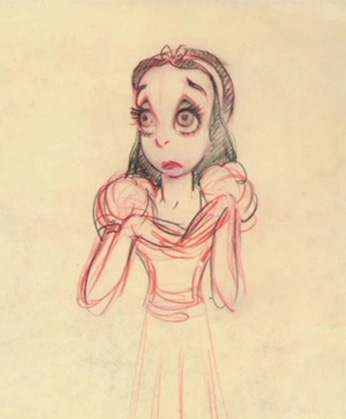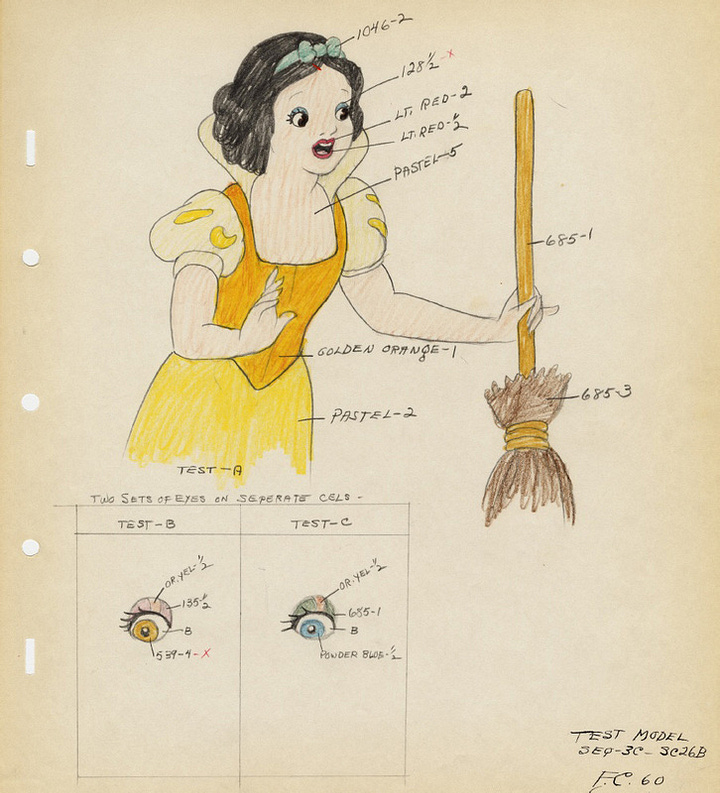After Snow White
Fairy tales... are the most vital connection we have with the imaginations of the ordinary men and women whose labor created our world. - Angela Carter
We owe the most influential version of the Snow White tale to Disney, whose 1936 film adapted it from the Brothers Grimm. But pieces of the story can be found in many legends around the world, and like all fairy tales, it has been the subject of scholarly analysis. Comparative mythology is a cranky discipline. It fixates on figures, symbols, and narrative, yet never consults those who truly inhabit these haunting stories. No one asks children what they think.
There are differences between Disney and Grimm. Grimm has Snow White roused from her deathlike sleep when the coach containing her coffin hits a rock and dislodges the bit of poisoned apple from her throat. It is accident and not the kiss of a prince which awakens this second Eve. In Grimm, the Evil Queen dances herself to death in red-hot iron shoes, a punishment met out by the prince’s father which recalls Hans Christian Anderson’s ‘Red Shoes.’ Curiously, a Portuguese Snow White variation replaces the poisoned apple with enchanted shoes. A figure dancing itself to death, tossed wildly around by a demonic pleasure machine, is an unforgettable and terrifying image.
Giambattista Basile, a 17th Century Italian poet and courtier, includes a story called ‘The Young Slave’ in his collection of Neapolitan fairy tales, the Pentamerone. His tale contains a virgin birth, a poisonous comb, a crystal coffin (actually seven), and a jealous stepmother, along with Bluebeard and hidden identity plot twists. The collection also includes ‘The Raven’, in which a king finds a stone raven which makes him dream of a lover who is “as black as the raven, as red as its blood, and as white as the stone.” In hope of curing the king’s fatal lovesickness, his brother visits a powerful magician. The magician’s daughter is the spitting image of the dream-girl. But aside from the three colors, there is little connection to Snow White.


The Italian philologist Angelo de Gubernatis collected a variant called ‘The Cruel Stepmother’ which adds a witch assistant and narcotic flowers; German folklorist Christian Schneller reports a version where the Evil Queen is three wicked sisters and the mirror and dwarves are supplanted by the moon. One of the more ingenious interpretations of the dwarves is that they were actually child laborers in the mines. According to another German academic, Snow White was inspired by Margaretha von Waldeck, a real-life noblewoman whose father owned copper mines and who may have been poisoned by her stepmother. Finally, there is even a new Disney Snow White film, but I have it on the highest authority that it is a total waste of time.
Snow White is born from her mother’s blood, as the Queen pricks her finger on a needle. Is this not the first death1? First blood, followed by the good Queen’s second and literal death in childbirth? For boys, the first death is later—la petite mort, which is beyond the scope of the story. In fact, men play very little part in Snow White at all. The king is a dupe, the prince is convenience of plot, and the dwarves are marginal people, creatures apart from men (which explains their kindness). The universe of the story is entirely feminine. The Wicked Queen is a victim of the god-like masculine mirror which projects a relentless and unbearable truth. This truth drives her to torture Snow White—a madness which is not of her making. The mirror sees and also judges her.
Disney’s masterpiece took visual inspiration from earlier films. The Wicked Queen was modeled on Helen Gahagan in She, a hit from the previous year, clad in a cool flapper outfit. Her aquiline face was modeled on Joan Crawford’s. Snow White was indebted to Hedy Lamarr, who had similarly rich dark hair. Lamarr had earlier appeared in the highly erotic film, Ecstasy, which had to undergo edits to pass the Hays Code in 1935 and was condemned by the Pope. An inventor and engineer as well as a fine actress, she later patented an early WIFI technology used in the war effort. Alan Turing, one of the fathers of modern computers, killed himself by eating an apple he’d injected with poison. Turning was persecuted for his sexuality by the England he helped save when he cracked the Nazi Enigma code. In gratitude, his bosses forced him to take female hormones and drove him to suicide. The history of Snow White and the Seven Dwarfs is thus tied to the female body, secret communication networks, eros and cyphers. And to injustice and the oppression of the unwanted. Perhaps also, the necessity of revenge.
Most of the painters and inkers working on Disney’s film were women. They filled in the countless cells of the beautiful animation strips with vibrant color by hand. It was a thankless, non-union job. Conditions for all the animators were pretty dire, with any attempt to strike being broken up by the Pinkerton thugs Walt hired as security. Disney had toured Mussolini’s Italy in 1935 and was favorably impressed with the dictatorship. He was even presented with a signed picture of Il Duce, but it isn’t certain that the two men ever actually met. Disney wasn’t all fascism, though. Italy later banned several of his cartoons, and it must be remembered that Sergei Eisenstein wrote a whole book about him. Sun Ra greatly admired Walt Disney, composing an album, Pink Elephants on Parade, based on Disney themes. He was one of the few white men to have ever created something truly beautiful, Sun Ra said.
The German author Robert Walser wrote a verse drama of Snow White. For Walser, she was exhausted by the repetition of her story: I know the story well… about the apple, the coffin. Be so kind as to tell me more. Why does nothing else come to mind? Must you hang on to these details? Must you forever draw on them? In 1956, Walser collapsed in the snow outside of the lunatic asylum where he spent the last decades of his life.
Folkloric studies have little to say about why we remain so captivated by Snow White or Little Red Riding Hood or Pinocchio. The mirror and the bright deadly apple, the wolf in old lady’s rags, the puppet lying on the workshop bench—these images form something more than a picture in the mind. Perhaps they answer to that strange overfull loneliness we feel when quite young, before that person which we will become must confront the world. Snow White is on the cusp of adolescence. She is between promise and betrayal, between skin and flesh, outside yet still staring inward. Fairy tales and legends stay with us because they are all that is left from an epoch in one’s life that is now inaccessible. Along with the stories, the time and place where you heard them return to you with a feeling which resembles a kind of pain.
The answer to what happens after renders the fairy tale mute. Once you ask the question, you no longer hear the story in the same way. Narrative has begun and narrative poisons a story. Narrative makes morality, makes purpose. Every tale is shattered by interpretation. Interpretation replaces the images of the mind with a landscape of concepts as dead and as cold as ice.
Writing makes dead: only after every worker knew them were these stories finally shut up into books. Fairy tales resist this concrete silence. They are constantly in metamorphosis yet they never change: Once upon a time. They do not so much end as simply stop: Happily ever after. Between these two points is the third drop of blood and the search for the girl of the snows.
Curiously, in Grimm’s original version of 1812, the Queen does not die. Jealous of her own daughter, she acts like the Wicked Stepmother/new Queen in all the later versions (Grimm’s final revision was published in 1857). But maybe this doesn’t matter. Snow White’s mother has somehow changed, whether supplanted by a new wife or by psychological forces.








This was a fun and well-researched read. My son has a tiny projector that was given as a present from his godmother. It came with several classic fables/fairytales that we'll watch in a dark room once in a while in place of traditional storytime. I've become fascinated with the dark and cruel undercurrents these stories have that must have taken generations--if not cenuries--to syncretize. They are always pointing to some basic uncomfortable truth about human nature.
I do ask Elliot what he thinks. He's three. And, sometimes, he can see the signpost.
Thanks for this. I understand more now why I keep a very battered old Hans Christian Andersen collection. It is a relic of my childhood imaginings. Just remembered The Little Mermaid having to dance on knives as she impersonated a human...